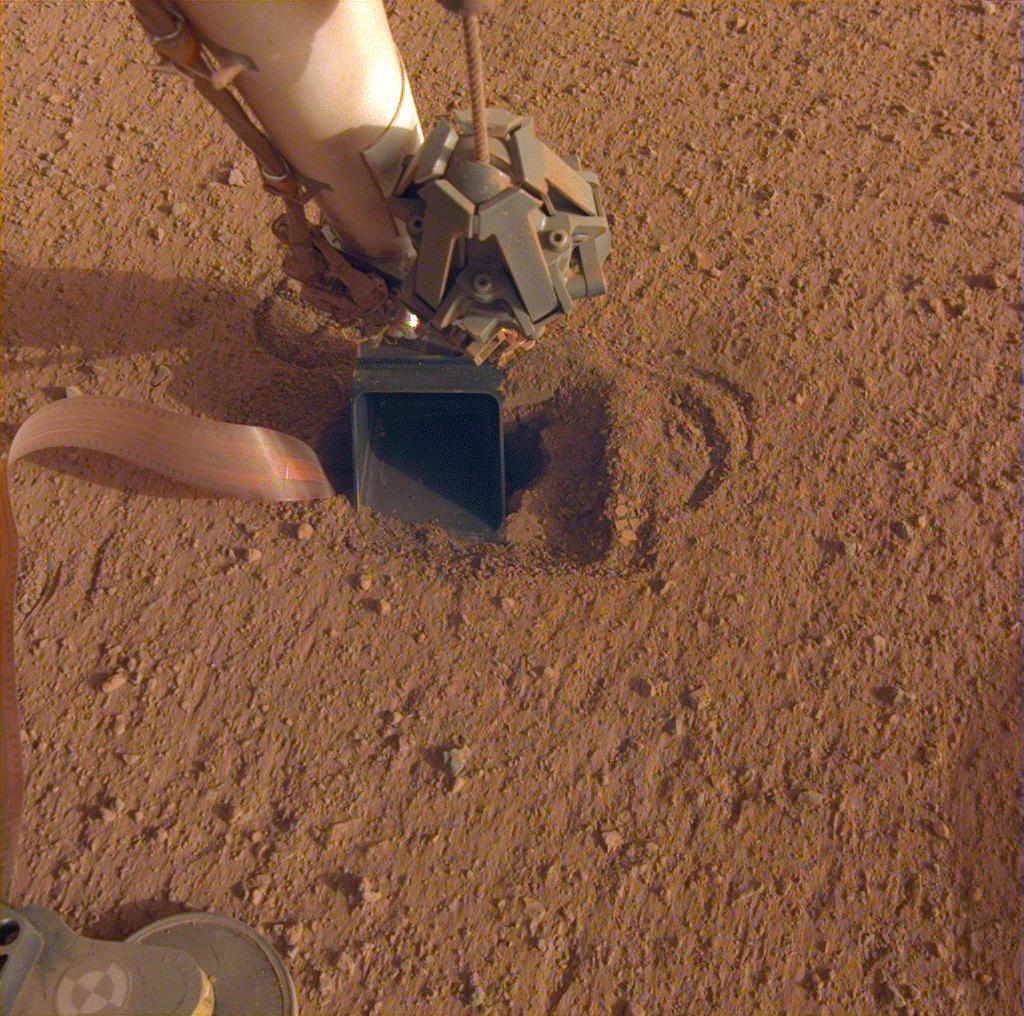The 'mole' on Mars from NASA's InSight lander may be stuck again

The Martian mole is underground again, but it may still not be able to dig on its own.
The burrowing heat probe onboard NASA's InSight Mars lander, affectionately known as "the mole," was designed to hammer itself at least 10 feet (3 meters) underground. But the going has been tough for the mole since its February 2019 deployment, perhaps as a result of weird soil properties at the landing site.
The mole, whose official name is the Heat Flow and Physical Properties Package (HP3), recently got underground once again, thanks to a push from the scoop on the end of InSight's robotic arm. But new photos suggest that the mole might be stuck in its new spot just beneath the surface.
Mars InSight in photos: NASA's mission to probe core of the Red Planet
"Images taken by InSight during a Saturday, June 20, hammering session show bits of soil jostling within the scoop — possible evidence that the mole had begun bouncing in place, knocking the bottom of the scoop," NASA officials wrote in an update Tuesday (July 7).
The InSight team can't fully assess the situation at the moment, because the scoop is blocking the mole from the view of a camera on the lander's arm. InSight's handlers plan to move the scoop out of the way over the next few weeks to get a good look at the mole and its burrow, NASA officials said.
Team members also plan to use that camera soon to image InSight's solar panels, something they haven't done since July 2019. It's the dusty season in InSight's locale just north of the Martian equator, and mission engineers want to get a better sense of the lander's power supply.
Breaking space news, the latest updates on rocket launches, skywatching events and more!
It's too soon to say what mole-aiding steps the team will take next. But one possibility involves moving nearby soil into the mole's pit to give the digger more friction, NASA officials said. The mole needs friction to bury itself deeper, and friction is apparently hard to come by in the cement-like "duracrust" beneath InSight's legs.
InSight landed on Mars in November 2018 to take an unprecedented look into the planet's deep interior, gathering information that will help scientists better understand the structure, formation and evolution of rocky planets.
The mole, which was provided by the German Aerospace Center, is one of two main science instruments onboard the lander. The other is a suite of incredibly sensitive seismometers provided by the French space agency CNES and its partners.
The seismometers have already detected more than 480 seismic signals. The detection rate has dropped significantly recently, a change that's likely tied to seasonal variations in atmospheric turbulence. This turbulence creates "noise" that swamps the signals of small marsquakes, NASA officials said.
The InSight team is also precisely tracking the lander's position on Mars. This work, done via analysis of InSight's communications, reveals how much Mars wobbles as it circles the sun. This information, in turn, will shed light on the size and composition of the Red Planet's core, NASA officials have said.
Mike Wall is the author of "Out There" (Grand Central Publishing, 2018; illustrated by Karl Tate), a book about the search for alien life. Follow him on Twitter @michaeldwall. Follow us on Twitter @Spacedotcom or Facebook.

Michael Wall is a Senior Space Writer with Space.com and joined the team in 2010. He primarily covers exoplanets, spaceflight and military space, but has been known to dabble in the space art beat. His book about the search for alien life, "Out There," was published on Nov. 13, 2018. Before becoming a science writer, Michael worked as a herpetologist and wildlife biologist. He has a Ph.D. in evolutionary biology from the University of Sydney, Australia, a bachelor's degree from the University of Arizona, and a graduate certificate in science writing from the University of California, Santa Cruz. To find out what his latest project is, you can follow Michael on Twitter.

